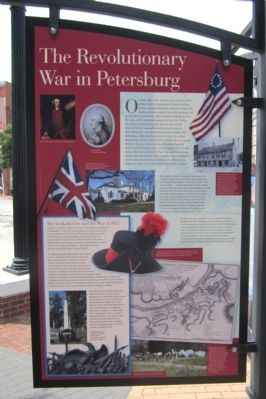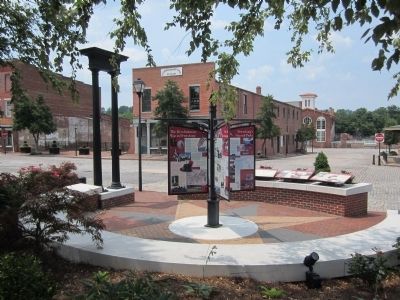Petersburg, Virginia — The American South (Mid-Atlantic)
The Revolutionary War in Petersburg
By the time the British had pressed their advance, the American militia had arrived at the bridge supported by an artillery battery posted on Baker’s Hill in what is now Colonial Heights. The Americans fought a fierce battle at the south end of the bridge. As the outnumbered Americans withdrew, they removed the plank flooring of the bridge to impede a British attempt to cross the river. By dark, the British troops had taken control of Petersburg and the American forces had withdrawn into Chesterfield County. The British troops burned some tobacco and a warehouse belonging to local merchants, then used Petersburg as a base to raid much of Central Virginia and to wait for General Cornwallis’ army to arrive.
On May 10th, American Major General Lafayette’s artillery shelled the British in Petersburg from across the river while an American supply train and reinforcements crossed the Appomattox upriver heading for American forces to the south. On May 13, 1781, General Phillips died of fever in Bollingbrook, a local estate owned by the Bolling family, and was buried at Blandford Cemetery. A few days later, Cornwallis finally arrived and combined the British forces. Cornwallis left Petersburg a few days later on his way to Yorktown and the eventual British surrender.
The Cockade City and the War of 1812
In 1812-15, America fought Britain in our “Second War for Freedom.” On September 1, 1812, the United States Government requisitioned 1,500 armed militia from Virginia. Petersburg’s militia, numbering some 75 men, was armed, equipped, and trained for war. The company made a long march to northern Ohio to the falls of the Maumee River. Upon arrival, the company joined others to construct a massive fort named Fort Meigs. In early May, the British and their Indian allies began a siege of the fort.
The Petersburg militia distinguished itself on May 5, 1813, the heaviest day of fighting during the siege. Along with other companies, they left the fort to attack a British artillery position. They charged the British positions, captured and spiked the British guns, and drove the enemy into the forest. Seventeen of Petersburg’s volunteers were wounded in the attack. Three of them died of wounds. General William Henry Harrison commended them for bravery. The Petersburg company was discharged with ceremony and commendations at Detroit on October 17, 1813. President Madison called Petersburg “The Cockade City of the Union” after seeing the Petersburg Volunteers on their return, wearing hats with leather cockades or emblems.
Two other residents of Petersburg were heroes of the War of 1812: General Winfield Scott commanded regular troops in campaigns in Canada, defeating the British in several engagements. Scott became Chief of the United States Army. He conquered Mexico in the Mexican War. Then as head of the United States Army, he devised the Union strategy to strangle the South in the 1861-65 War. Lieutenant Colonel Abraham Eustis distinguished himself in the campaigns along the Canadian border, Fort Eustis, Virginia, is named for him.
Erected by City of Petersburg.
Topics and series. This historical marker is listed in these topic lists: War of 1812 • War, US Revolutionary. In addition, it is included in the Former U.S. Presidents: #04 James Madison, and the Former U.S. Presidents: #09 William Henry Harrison series lists. A significant historical month for this entry is April 1866.
Location. 37° 13.988′ N, 77° 24.266′ W. Marker is in Petersburg, Virginia. Marker is at the intersection of East Old Street and Rock Street, on the right when traveling east on East Old Street. Touch for map. Marker is at or near this postal address: 9 E Old St, Petersburg VA 23803, United States of America. Touch for directions.
Other nearby markers. At least 8 other markers are within walking distance of this marker. African-Americans in Petersburg (here, next to this marker); Arts & Recreation (here, next to this marker); Petersburg Museums (here, next to this marker); Architectural Heritage (here, next to this marker); Pamplin Historical Park (here, next to this marker); Petersburg National Battlefield (here, next to this marker); Petersburg’s Natural Parks (here, next to this marker); Petersburg Region (here, next to this marker). Touch for a list and map of all markers in Petersburg.
More about this marker. The marker contains several photographs with the captions:
British Commander Major General William Phillips
Major General Friedrich von Steuben
Every April the City hosts a reenactment of the battle fought at Battersea on April 25, 1781.
An archaeological excavation one block west, exposed the foundation of the Golden Ball Tavern, seen above. Built in 1760 by Richard Hansen, an English tobacco merchant and an outspoken loyalist, the tavern was commandeered for officer quarters during the British occupation of Petersburg in 1781.
The hat at left was made for the Petersburg Museums to match the description of the one worn by Petersburg troops during the War of 1812. The black rosette was called a cockade.
The McRae monument at Blandford Cemetery commemorates Petersburg’s contribution to the War of 1812.
The map above was drawn by John Hills. The caption is Sketch of the Skirmish at Petersburg between the Royal Army under the command of Major Genl. Phillips and the American army commanded [sic] by Major Genl. Steuben in which the later were defeated April 25, 1781 copied from a sketch of Lt. Spencer by I.H. Hills, Lieutenant 23d Regt. & Asst. Eng’r., at Endicott.
Revolutionary War reenactment at Battersea.
Additional commentary.
1. Amos Stoddard: Participant in the Artillery Action from Baker’s Hill May 1781
In his unfinished autobiography manuscript, written in 1812, and published in the book, The Autobiography Manuscript of Major Amos Stoddard in 2016, Amos Stoddard describes the action that took place at Petersburg during Lafayette’s Maryland and Virginia Campaign in 1781. His historical account covers the beginning of the campaign, from Trenton, New Jersey in February, to the Head of Elk, descending the Chesapeake River to Annapolis, Maryland, and victoriously concluding with the surrender of Cornwallis’ forces at Yorktown in October 1781.
While his testimony of the campaign is quite extensive and detailed, one passage sums-up the campaign in a very efficient manner. He states, “It belongs to history to detail the events of a campaign, at the close of which we captured a British army, and by this means put an end to the war. It is therefore sufficient to remark, that from about the first of June to the siege of Yorktown in October, our troops were constantly on the march. They were seldom encamped more than two days at any one place...”
Regarding the events at Petersburg, the following excerpt is taken from his written words:
[In early May, 1781], part of the British army was encamped at Petersburg on the south side of the Appomattox [River], and the Marquis resolved to beat up their headquarters...this detachment of the British army was commanded by Gen’l [William] Phillips and the infamous [Benedict] Arnold acted under him. We completely surprised them. Our first salutation was the discharge of several six pounders from a considerable elevation; the shot racked their line of tents...the British soldiery precipitated into a woods beyond our reach...When we first rose the hill, the Marquis steadily watched the quarters of Arnold with his glass. He soon discovered him mounting his horse. We instantly leveled our pieces at him - but the distance was too great, and although we covered him with dust, yet we had the mortification to see him join the troops in the woods...We saw several men fall — two in particular at whom we leveled three pieces, after they exposed themselves, and by their sign bid defiance. The mansion at Baker’s hill was deserted and was said to belong to a refugee. An office adjoining contained several hundred volumes of choice books - and I was sorry to see these plundered by the soldiery - and more so by some officers, who I am convinced, were never benefited by their contents.
— Submitted March 17, 2021, by Robert Stoddard of Idyllwild, California.
Credits. This page was last revised on February 2, 2023. It was originally submitted on July 10, 2012, by Bernard Fisher of Richmond, Virginia. This page has been viewed 781 times since then and 35 times this year. Photos: 1, 2. submitted on July 10, 2012, by Bernard Fisher of Richmond, Virginia.

